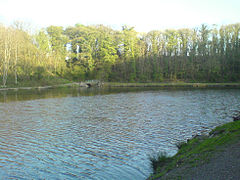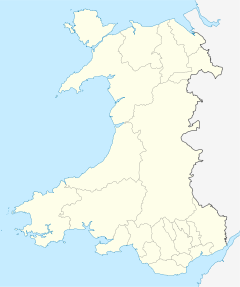- Moss Valley, Wrexham
-
Coordinates: 53°03′50″N 3°01′44″W / 53.0638°N 3.0289°W
Moss Valley 
Fishing Lake
 Moss Valley shown within Wales
Moss Valley shown within WalesOS grid reference SJ310523 List of places: UK • Wales The Moss Valley (Welsh: Dyffryn Moss, pronounced [dɪˈfrɪn ˈmɒs]) is an area and country park in Britain. It is in the county borough of Wrexham, in north Wales. The area is also informally known as "The Moss" and The Aggey amongst locals. It is most well known for its extensive coal mining history. [1]
Contents
History
Thomas Telford
In 1796, a feeder reservoir lake was constructed in the Valley for an extension of the Ellesmere Canal under Thomas Telford. The canal would have eventually served as an extension from Trevor Basin. This plan was abandoned in 1798. Remnants of the canal are still visible in nearby Gwersyllt, and a street in the village is named Heol Camlas (Welsh: Canal Way). Telford's lake is not the lake that is currently present in the valley[2].
Collieries
Throughout the 19th Century and early 20th Century, the Moss Valley was the home to the Westminster Colliery in its northern end, and Gatewen Colliery at the southern end. The coal was distributed both locally and nationally through major railway links, much of which was built specifically for the distribution of goods. The colliery's railways were linked to neighbouring Great Western Railway lines. This originally was the Wheatsheaf Branch which ran from the Wheatsheaf Junction of the Chester line, then up a worked incline up Gwersyllt Hill, and then through the 220ft Summerhill Tunnel to Westminster Colliery. The line then continued through the other side of the valley through the 400ft Brymbo Tunnel, up a second worked incline to Brymbo Steelworks. The western portal of the Summerhill Tunnel is still visible as of 2008, although its eastern portal and both portals of the Brymbo tunnel have been buried. [3] In 1862 the GWR Ffrwd Branch from the Croesnewydd Junction was opened to transport railway traffic over a much more 'normal' terrain between the Chester line and Brymbo, replacing the Brymbo half of the Wheatsheaf Branch. A Moss Branch was later created from the Ffrwd Branch, making the Wheatsheaf Branch, its brake inclines and two tunnels defunct by 1908. [2] The Great Central Railway Brymbo Branch also ran through the valley, and the Moss Valley station is still visible.
Much of the local working force relied on these collieries for both income and fuel. Westminster Colliery closed in February 1925, but the remnants of the industry were not removed until the early 1970s. It closed mainly due to water leakage, but this was the beginning of a declining industry.[4]
Recent history
In the early 1970s, the area was reclaimed as a country park. The finished area was to include two lakes (one "north" boating lake complete with boat storage, and one "south" smaller lake which includes an island at the centre), a children's playground, public toilets, a golf club, facilities for fishing and various benches and picnic tables. Through the 80's and 90's the area was heavily vandalised, leading to the loss of boating and public toilet facilities.
However, in the early 21st Century, the area was donated grants for restoration. Both lakes were cleaned, and fishing was restricted to private permit holders only. Paths were given new surfaces, information signs and benches were erected, and bridges were repaired. The north former-boating lake was re-targeted towards conservation, and water plants were added to the water. Many species of coarse fish, and Ancona ducks can now be found in the lakes, a sure sign of an improvement. Many of the former railway trackbeds were transformed into nature walks, and steps were installed on banks. Gates and fences were erected to prevent the use of motor vehicles in the lake areas. However, both the toilets and former boat-house remain empty. Throughout 2005 and 2006, the original playground was dismantled and eventually replaced in 2007 (pictured below).
The area is now an official country park, and attracts many visitors including those interested in its industrial history and its wildlife amongst its waters and woodlands. It highly successful golf club still provides to its newer course, just over the road from the original one (now a free "pitch and putt" 9-hole course).
Photographs
Notes and references
- ^ - WCBC: Moss Valley Country Park
- ^ a b Local Timeline @ Coedpoeth Minerahistory.com
- ^ Forgotten Relics - Summerhill and Brymbo Tunnels
- ^ With reference to The North Wales Coalfield by Ithel Kelly, 1990.
External links
Categories:- Villages in Wrexham county borough
- Visitor attractions in Wrexham county borough
- Country parks in the United Kingdom
- Country parks in Wales
Wikimedia Foundation. 2010.




